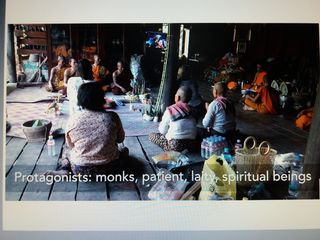
In November 2019, I attended a presentation in London by Dr. Sylvia Mohr, a Swiss psychologist working in Siem Reap City, Cambodia, near the site of the famous Angkor Wat temple ruins. It began with a fascinating 20-minute video of a long ritual, conducted by Khmer Buddhist monks in a small pagoda in Cambodia. The purpose of the three-hour proceedings was to cure a young French woman of an enduring and disabling psychiatric illness. Impressively, it seemed to work.
According to Dr. Mohr, the same "karma-reset" procedure was effective too for several other Westerners with mental illnesses, chronic pain, and other long-lasting, debilitating conditions. Importantly, the benefits were sustained when the subjects were re-investigated at up to a one-year follow-up. In a region with no psychiatric hospital, and only three psychiatrists for over one million people, it seems important that it works in about two-thirds of local cases as well.
Such healing rituals are rare events, to be performed in a sacred place that has been purposefully decorated with symbols and icon graphics that tell the story of Buddhist beliefs. The affected person has to meet the head monk first, to request the ritual, then a favourable date is set, according to the person's horoscope.

The ritual in the video consisted of the symbolic death of the troubled person, the search for and re-integration of her 19 lost pralungs ("souls"), an exercise to rid her of evil spirits and bring to an end the bad "karma" of past-life errors, followed by her symbolic rebirth, cleansed and whole.
Throughout, the young woman was in a deep hypnotic trance while the monks chanted Buddhist texts and teachings in the Pali language. Together with selected lay people, they also sang poetic traditional folk songs calling back the lost souls. Several ritual objects were involved, including a miniature bamboo coffin in which an effigy of the sick woman was placed and eventually burnt, Buddha images to dispel the demons, 19 coins representing the lost souls, candles, incense, also a long, bright red cotton thread representing the individual's whole and healthy subtle continuum of consciousness persisting from one life to the next. There was no need, we were informed, for the person to understand the languages, be a Buddhist or believe in reincarnation for the procedure to bring about cure.

The entire process involves telling a story using protagonists played by the senior monk and four other monks initiated by him, several laywomen, the patient, and her relatives. It involves prescribed words and actions to signify the patient's relationship with the sacred and keeps strictly to a formal, traditional ceremony to be performed in an appropriately serious mood and manner. It represents a three-stage rite of passage: i) separation from ordinary life, opening to the world of the sacred, ii) transitional state (limbo), a short period when the rationality of everyday life, social conventions, and structures are put aside, the person in a deep trance experiencing an altered state of consciousness and a sense of transcendence, iii) re-incorporation, return to everyday life.
Afterward, on camera, the Frenchwoman said: "Before coming, for some time, I was in a kind of bubble, in a cage shaped by myself... The worst cage ever. I was a prisoner in this cage... But the ceremony was one of the most special and natural experiences I've ever felt. It was very special. They were extremely melodious songs. It was magnificent. I was in a kind of meditation state, I was in a kind of energetic bubble. And what is crazy is that things came to me that I never knew, songs, sounds and at the same time, it was incredibly natural. And now I feel ... empty, but not in euphoria, I'm ... Now I feel nothing, even to say I feel something does not make sense, because I'm just a part of a whole. Really... I'm okay!" According to Dr. Mohr, she had been transformed and fully freed from the burden of her former symptoms and self-doubt.
Giving more detail, the patient said: "During the ceremony, words came to me, sensations suggesting, 'You have to think about this idea.' I knew somehow that I had to work on this idea, that I have to do certain things and not do other things. At times I saw great light, and at times I experienced things that were physical. For example, my mouth relaxed into a smile by itself. There were times when I felt super strong vibrations throughout my body that were extremely uncontrollable. I did not have visions of the future, but I saw people I love. I saw them coming, and they sent me messages of love... It was extraordinary."
The healing procedure apparently allows the person to enter a modified state of consciousness, a hypnotic trance, to enter the liminal, cross-over world of the divine, to be transformed by this mystic experience, and to return to everyday life by integrating this transformation. The ritual is effective, according to CG Jung, because the unconscious is a source of wisdom and healing; the human psyche naturally produces religious, numinous, and mystical experiences. Really effective therapy depends on this encounter, making a connection with the sacred.

According to Dr. Mohr, along with the hypnosis involved, by which all rationality is short-circuited, key elements for effective healing include requesting and receiving forgiveness for previously harmful behaviour, together with hope for relief of suffering and a better future in which the patient, healthy again, can feel fully part of their ongoing life, contributing meaningfully to relationships and the wider community. This aspect is strengthened by the ritual, during which the songs have soothing physiological effects on breathing and heart-rate leading to a state of relaxation. Because all the protagonists adapt to the same rhythms, a powerful feeling of communion and fellowship develops between them all.
The audience of psychiatrists and their invited guests in November were duly impressed by the presentation. In discussion, it was generally agreed that the young Frenchwoman had been enabled by the ritual to cross a threshold and enter a "liminal" state, allowing her paradoxically to be, as it were, both dead and alive at the same time. She crossed over and, importantly, through the good offices of the religious and experienced lay people present, she was able later to return. The question remains, "Could Western psychologists and psychiatrists learn, and their patients benefit, from some kind of ritual like this?"
Copyright Larry Culliford
Larry supports the World Wide Wave of Wisdom and you can hear his interview with Daniela Norris about his books and ideas here (25 min).




